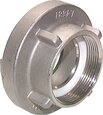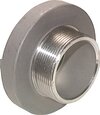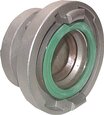Storz Coupling Guide
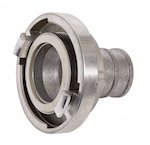
Figure 1: Storz coupling
Storz couplings are often used and designated as fire hose couplings. However, they have wide usage in many industries, including refineries, agricultural, construction, maritime safety, and military use due to their resistance against corrosion, acids, and water. Storz couplings are non-shut-off symmetrical couplings and are also known as fire hose fittings. They can be connected by plugging the lug parts into each other and then twisting against each other. These couplings are ideal for working with water and other fluids, while users can also use them as connecting couplings for connecting other hose types.
Table of contents
- Considerations when selecting Storz couplings
- Storz coupling advafntages
- Storz coupling lug distance
- Storz hose connections
- Storz accessories
Considerations when selecting Storz couplings
Storz couplings, or fire hose fittings, have a symmetrical design with a bayonet locking system protected by a collar. Storz couplings are used for connecting either hoses or connectors together. As these couplings are symmetrical, both sides of the coupling are the same. This adds a safety feature as the connection can only be made in one manner. Storz couplings are fitted as standard with an NBR seal; however, different seal materials are available.
Storz coupling advantages
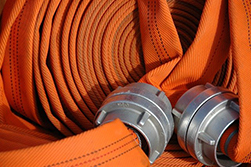
Figure 2: Storz couplings connected to fire fighting hoses
- Aluminum Storz couplings are forged instead of cast, making them stronger and minimizing the risk of breaking.
- Standard Storz couplings are rated for a maximum operating pressure of 16 bar (232 psi). This can be higher or lower if specified with the specific coupling.
- Available in aluminum, brass, and stainless steel.
- Replacement seals are available in NBR, NBR white, Silicone, and FPM.
- Storz couplings are easy to assemble and disassemble manually. If the coupling does get jammed after being pressurized, the use of a Storz wrench might be necessary.
- All Storz couplings of the same size have the same lug distance, making them compatible.
Storz coupling lug distance
Storz couplings are easily identifiable by the lug distance. To find out the lug distance of a coupling, measure the inside distance between the lugs with a pair of calipers. The following are the most common Storz couplings and their lug distances, commonly identified with letter designation:
- D-couplings (lug distance 31 mm)
- C-couplings (lug distance 66 mm)
- B-couplings (lug distance 89 mm)
- A-couplings (lug distance 133 mm)
Storz hose connections
Storz couplings are available in a wide variety of connections and types. The most common are:
- Male or female thread: As the name implies, the second connection point on the coupling can have either male or female threads to screw into a component.
- Hose pillar: Storz couplings with hose pillars are often employed in static fire fighting situations. As the hoses do not move around as much, they dont become entangled. Other applications include agricultural, military, and maritime use.
- Elbow rotatable hose pillar: This Storz coupling has a rotatable hose connection. The rotation prevents a hose from becoming entangled and, as such, is particularly popular for use in firefighting and agriculture.
- Flange connection: Flange connections are one of the most common connections. The couplings are joined by bolting together the flanges with a gasket in between.
- Storz reducer: Storz reducers are vital equipment to connect hoses, pipes, and couplings of different sizes.
Storz accessories
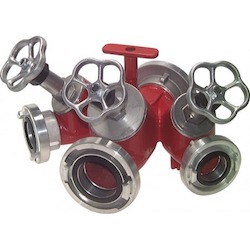
Figure 3: A Storz distributor
Besides couplings, there is a wide array of Storz accessories. These include:
- DIN 14365 jet pipes: Storz jet pipes come with a handle for 3-way operation: shut off, full jet, and spray jet.
- Storz distributors and collectors: Storz distributors and collectors offer various solutions for collecting and distributing hoses and are available with shut-off valves.
- Standpipe hydrants: There are both aboveground as underground standpipes. Aboveground standpipes are mainly used for buildings and in bridges in the United States. Underground standpipes are used mainly in countries where fire hydrants have been placed underground. The standpipe can be connected to the hydrant by the fire department.
- Storz coupling caps: Storz coupling caps are largely used to close fire department connections and hydrants, but they can be used anywhere Storz-coupled hoses are used. To shut down a pipe while transferring powders, granates, and liquids from one location to another, chemical manufacturing facilities, steel mills, bulk shipping tanks, etc. rely on Storz caps.
- Keys: While Stroz couplings may be connected and disconnected manually, a coupling can become jammed and a Storz key will be useful in this case.
- Safety clamps: The steel safety clamp is suitable for all Storz couplings and is equipped with a lug mechanism providing a strong grip on the coupling to keep the two halves of the coupling mechanism together.
- Protective cages: Used in particular in combination with pumps, the protective cages for Storz couplings are designed to prevent large debris, leaves, twigs, and other materials from entering the system.
To learn more about different couplings and fittings, read our couplings article.





